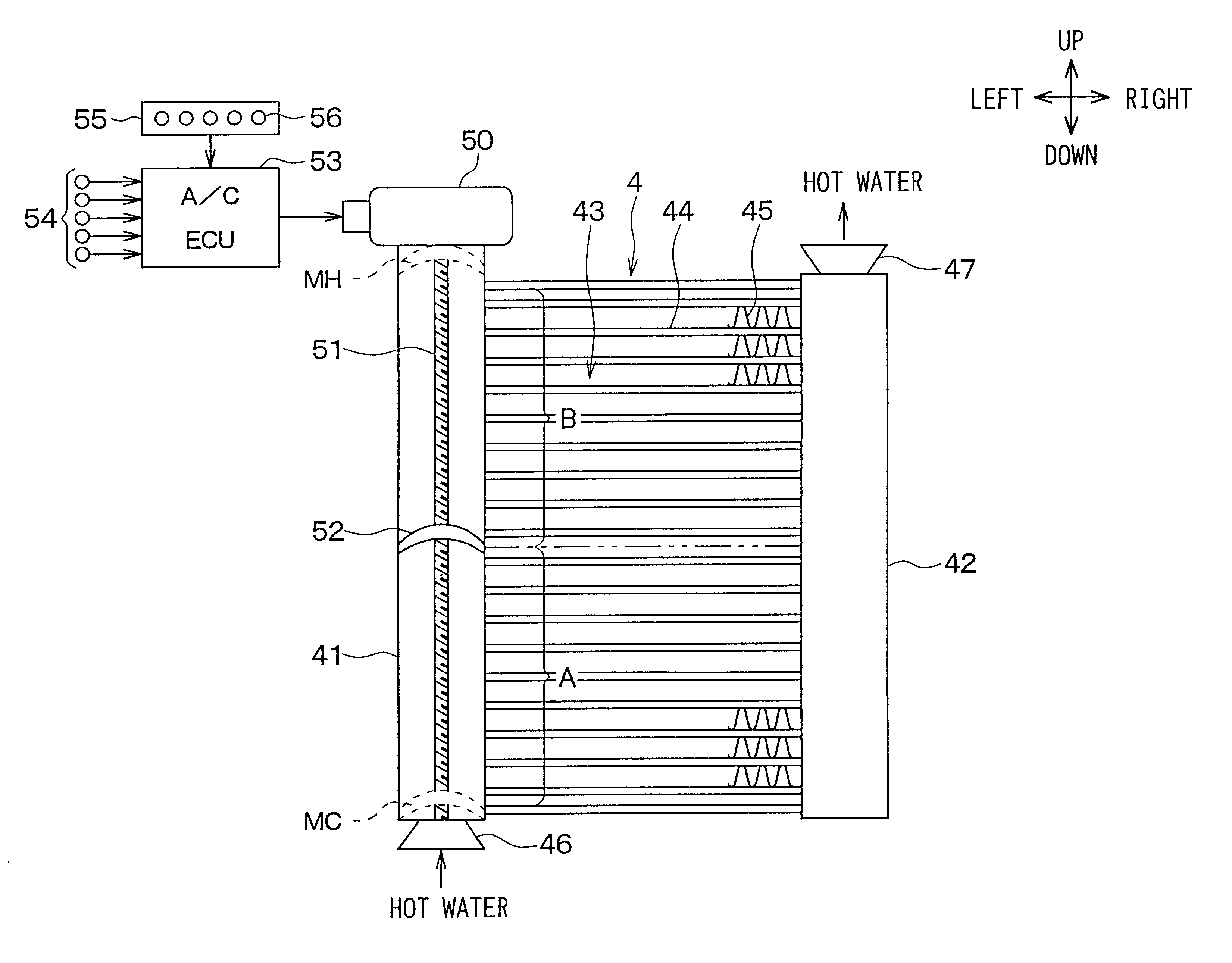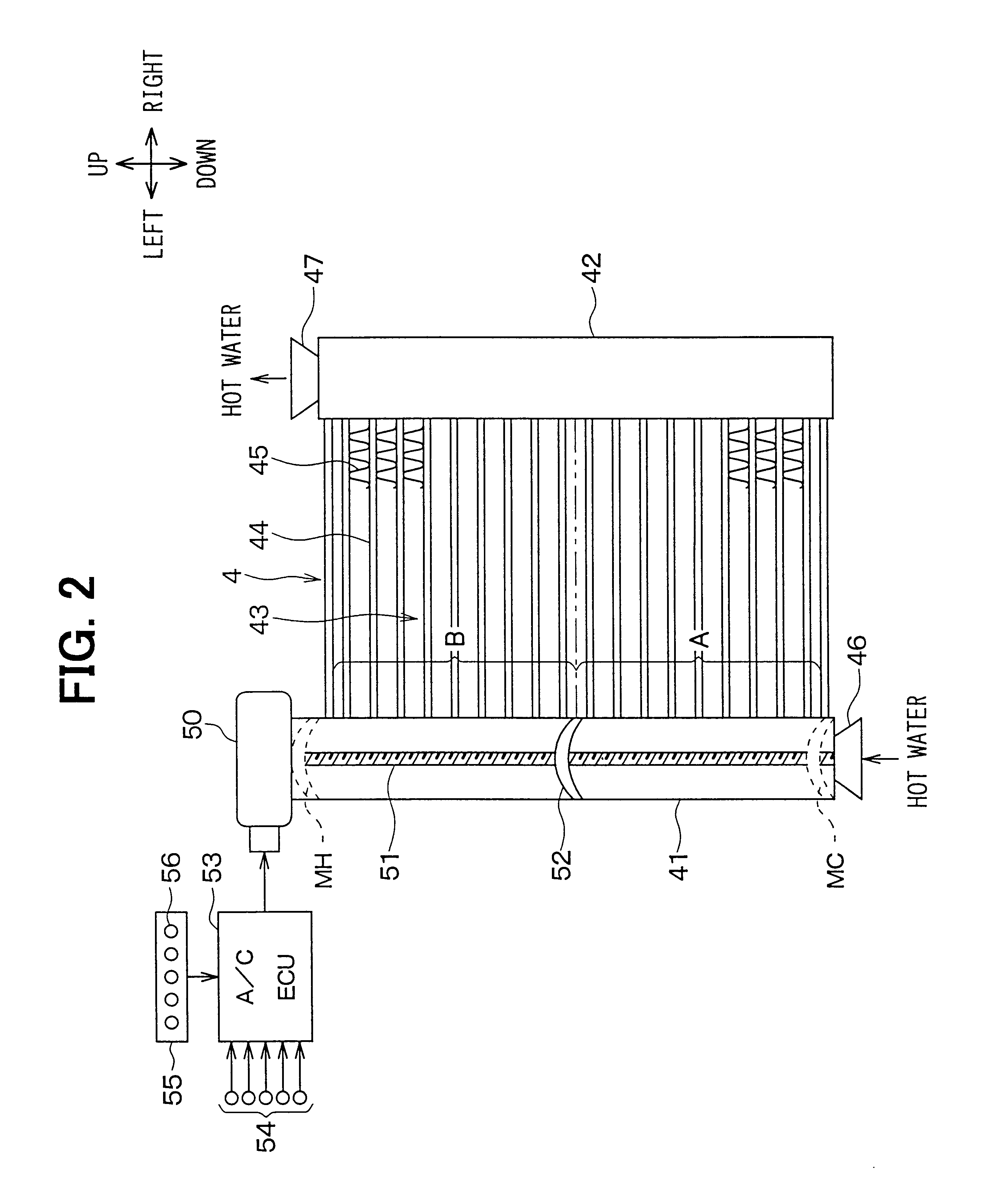Vehicle air conditioner with flow area adjustment of fluid in heating heat exchanger
a technology of flow area adjustment and vehicle air conditioner, which is applied in the direction of indirect heat exchangers, ducting arrangements, lighting and heating apparatus, etc., can solve the problems of increased production cost of hot water valves, difficulty in continuously adjusting the temperature of air blown into passenger compartments, and inability to quickly respond to a change in the flow amount or the temperature of hot water
- Summary
- Abstract
- Description
- Claims
- Application Information
AI Technical Summary
Benefits of technology
Problems solved by technology
Method used
Image
Examples
second embodiment
(Second Embodiment)
In the above-described first embodiment, the heater core 4 is disposed to cross the entire section area of the air passage in the air conditioning case 1a so that all air from the evaporator 3 passes through the heater core 4. However, in the second embodiment, as shown in FIG. 4, the height of the heater core 4 is made smaller than that of the evaporator 3, and a cool-air bypass passage 60 is provided above the heater core 4 in the air conditioning case 1a. The cool-air bypass passage 60 is opened and closed by a bypass door 61, and the bypass door 61 is driven by an actuator (not shown) controlled by the air-conditioning electronic control unit 53. When the cool-air bypass passage 60 is opened by the bypass door 61, cool air having passed through the evaporator 3 can be directly introduced to at least one of the defroster opening 5 and the face opening 6 through the cool-air bypass passage 60.
In an air outlet mode such as a foot / defroster mode where the defroste...
third embodiment
(Third Embodiment)
In the above-described first and second embodiments, the flow control member 52 is movably disposed only in the inlet tank 41 of the heater core 4. However, in the third embodiment, as shown in FIG. 5, two flow control members 52a, 52b are movably disposed in the inlet tank 41 and the outlet tank 42 of the heater core 4, respectively. Therefore, two actuators 50a, 50b and two screw rotation shafts 51a, 51b are disposed for the flow control members 52a, 52b, respectively.
Accordingly, in the third embodiment, the flow control members 52a, 52b can be independently moved to desired positions by the actuators 50a, 50b, respectively. Therefore, the flow amount ratio between the hot air and the cool air, that is, the number ratio between the water-flowing flat tubes 44 where hot water flows and the non-water-flowing flat tubes 44 where no hot water flows can be adjusted as in the first embodiment. In addition to this function, the positions of the water-flowing flat tubes...
fourth embodiment
(Fourth Embodiment)
In the above-described first to third embodiments, hot water flows in one way from the inlet tank 41 to the outlet tank 42. However, in the fourth embodiment, hot water flows in the heater core 4 while being turned in a U-shape in an air flow direction D, as shown in FIGS. 6A-6C. Specifically, the inlet tank 41 and the outlet tank 42 are disposed at one end side of the heater core 4 in the vehicle right-left direction, to be arranged adjacent to each other in the air flow direction D. As shown in FIGS. 6B, 6C, the outlet tank 42 is disposed at an upstream side of the inlet tank 41 in the air flow direction D, thereby improving heat-exchange efficiency between air and hot water. Here, the flat tubes 44 are composed of plural first tubes 44a disposed at a downstream air side to communicate with the inlet tank 41, and plural second tubes 44b disposed at an upstream air side of the first tubes to communicate with the outlet tank 42.
In the heater core 4, a connection t...
PUM
 Login to View More
Login to View More Abstract
Description
Claims
Application Information
 Login to View More
Login to View More - R&D
- Intellectual Property
- Life Sciences
- Materials
- Tech Scout
- Unparalleled Data Quality
- Higher Quality Content
- 60% Fewer Hallucinations
Browse by: Latest US Patents, China's latest patents, Technical Efficacy Thesaurus, Application Domain, Technology Topic, Popular Technical Reports.
© 2025 PatSnap. All rights reserved.Legal|Privacy policy|Modern Slavery Act Transparency Statement|Sitemap|About US| Contact US: help@patsnap.com



